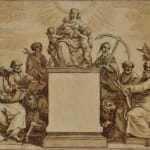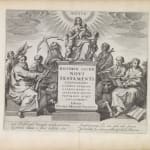
After Pieter de Jode the Elder, The Three Theological Virtues Fides (Faith), Spes (Hope) and Caritas (Love) Surrounded by the
Four Evangelists with their Attributes, engraving, 222 x 262 mm, frontispiece for the New testament, in:
Claes Jansz Visscher, Theatrum Biblicum, Amsterdam, 1639 (this ed. 1643), Amsterdam, Rijksmuseum.
Pieter de Jode (Antwerp 1573 - 1634)
The present, superbly executed washed pen drawing was done by De Jode in preparation for a sumptuous picture bible with large numbers of engravings by and after many famous artists of the past and present – e.g. Maerten van Heemskerck (1498-1574), Maerten de Vos (1532-1603), Hans Sadeler (1550-1600), Michiel Coxcie (1499-1592), Karel van Mander (1548-1606), Harmen Muller (1539-1617) and De Jode himself. The copperplates for this project were largely part of Pieter’s father Gerard’s seminal illustrated bible Thesaurus Sacrarum Historiarum, first published in Antwerp in 1579. Although it might at one point have been Pieter’s intention to publish an update of the Thesaurus, he at any rate never finished this project. Instead, it was decided to sell the copperplates and designs. In 1612 the plates were owned by the widow of the Antwerp print seller Jan-Baptist Vrients. Finally they ended up with the draughtsman, engraver, mapmaker, and publisher Claes Jansz Visscher (c. 1587-1652) in Amsterdam. Visscher added another 150 engravings – for a considerable part based on Antwerp designs – and published his picture bible, the Theatrum biblicum : hoc est historiae sacrae veteris et novi testamenti tabulis aeneis expressae in 1639.
Our drawing is the modello for the engraved frontispiece of Visscher’s picture bible’s New Testament section (see ill.). Depicted are the three theological virtues – as set forth by St. Paul in 1 Corinthians 13 – Fides (Faith), Spes (Hope) and Caritas (Charity, or Love) surrounded by the four Evangelists and their attributes. Seated on the central pedestal is the most important theological virtue Charitas, traditionally represented as a mother of three children. To her left we see St. John with his attribute, the Eagle, St. Luke with the ox, and Fides with her cross. To the right Hope, with her attribute the anchor, stands next to St. Mark with his lion, and St. Matthew with the angel. De Jode’s design was clearly meant to visually match the design of the Theatrum Biblicum’s general frontispiece, which likewise makes use of a central altar, here surrounded by Moses and Aaron to the left, and King David and a prophet to the right, thus referencing the Old Testament.
While the stylistic coherence with Pieter de Jode the Elder’s output leaves no doubt about his authorship of the present design, this authorship is confirmed once more by the mentioning of his name (‘Pieter de Iode invent’) underneath a variant of the 1643 frontispiece – this time without the altar and the three theological virtues – used in a subsequent edition of the Theatrum Biblicum, the so-called Royal-Sized Bible, likewise published in Amsterdam, by Claes Jansz Visscher’s son, Nicolaes Visscher (1618-1679), c. 1652.
The surfacing of our drawing confirms the suspicion that De Jode kept working on a new edition of his father’s Thesaurus with numerous new designs, if not ‘in-house’, then at least actively involved in the project after it had been adopted by another publisher, in all probability Claes Jansz Visscher in Amsterdam. The terminus ante quem for this involvement is obviously De Jode’s death in 1634, which seemingly implies that Visscher bought the copperplates before that date. A so-far unidentified watermark found in our sheet might shed more light on the chronology of De Jode’s contributions.


